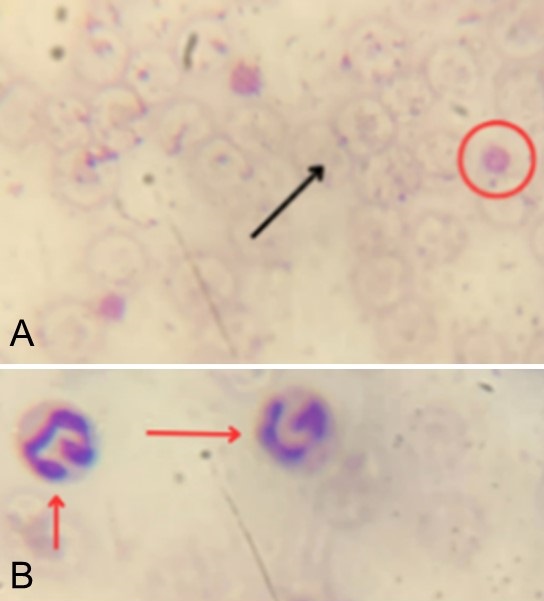Hematologic profile of tick paralysis in a domestic cat
Abstract
Tick paralysis is a toxicosis in animals caused by the infestation of ectoparasites, such as lice or ticks, which secrete neurotoxins that lead to muscle paralysis. This article reports the haematology findings of a 2-year-old male domestic cat diagnosed with tick paralysis at the West Java Provincial Veterinary Hospital. The cat, recently adopted as a stray, presented with hind limb incoordination, Ctenocephalides felis infestation, decreased appetite, constipation, and dehydration. Physical examination revealed the cat was severely underweight (BCS 1/5) with abnormal vital signs, including a rectal temperature of 37°C, respiration rate of 10 bpm, and pulse rate of 260 bpm. Haematological analysis showed granulocytosis, macrocytic anaemia, and thrombocytopenia. The cat was treated with doxycycline, cyproheptadine, vitamin and mineral supplements, iron dextran, NaCl 0.9%, and tick removal. This case underscores the importance of haematological monitoring in managing tick paralysis and ensuring an adequate treatment response.
Downloads
References
Jinna S, Khandhar PB. 2019. Thrombocytopenia. StatPearls Publishing.
Cadet JL, Bolla KI. 2007. Neurology and Clinical Neuroscience. 1477-1488. https://doi.org/10.1016/B978-0-323-03354-1.50115-2
Do T, Kamyingkird K, Chimnoi W, Inpankaew T. 2021. Evaluation of hematological alteration of vector‐borne pathogens in cats from Bangkok, Thailand. BMC veterinary research. 17:1-9. https://doi.org/10.1186/s12917-020-02737-1 | PMid:33455579 PMCid:PMC7812637
Honnas CM, Athey JM, Verocai GG, Snowden KF, Esteve-Gasent MD, Mankin JM. 2020. Apparent Ixodes tick paralysis in a cat from North America. Journal of Feline Medicine and Surgery Open Reports. 6(2):2055116920964001. https://doi.org/10.1177/2055116920964001 | PMid:33117555 PMCid:PMC7570782
Kaferle J, Strzoda CE. 2009. Evaluation of macrocytosis. American family physician. 79(3):203-208.
Moore CA, Adil A. 2022. Macrocytic Anemia. StatPearls Publishing.
O'Keeffe T, Donaldson RE. 2023. Mechanical ventilation in dogs and cats with tick paralysis. Frontiers in Veterinary Science. 10:1071191. https://doi.org/10.3389/fvets.2023.1071191 | PMid:37089405 PMCid:PMC10117792
Siemińska I, Poljańska E, Baran J. 2021. Granulocytes and cells of granulocyte origin-the relevant players in colorectal cancer. International Journal of Molecular Sciences. 22(7):3801. https://doi.org/10.3390/ijms22073801 | PMid:33917620 PMCid:PMC8038777
Stone KD, Prussin C, Metcalfe DD. 2010. IgE, mast cells, basophils, and eosinophils. Journal of Allergy and Clinical Immunology. 125(2):S73-80. https://doi.org/10.1016/j.jaci.2009.11.017 | PMid:20176269 PMCid:PMC2847274
Tilley LP, Smith Jr FW, editors. 2015. Blackwell's five-minute Veterinary consult: canine and feline. John Wiley & Sons.
Voigt GL, Swist SL. 2011. Hematology techniques and concepts for veterinary technicians. John Wiley & Sons.
Wang Y, Watters N, Jones E, Padula A, Leister E, Haworth M, Henning J, Allavena R. 2022. Pulmonary histopathology in cats and dogs with fatal tick paralysis. Journal of Comparative Pathology. 197:44-52. https://doi.org/10.1016/j.jcpa.2022.07.005 | PMid:36089296

Copyright (c) 2024 CC-BY-SA

This work is licensed under a Creative Commons Attribution-ShareAlike 4.0 International License.
Authors who publish with this journal agree to the following terms:
1. Authors retain copyright and grant the journal right of first publication with the work simultaneously licensed under a Creative Commons Attribution License that allows others to share the work with an acknowledgement of the work's authorship and initial publication in this journal.
2. Authors are able to enter into separate, additional contractual arrangements for the non-exclusive distribution of the journal's published version of the work (e.g., post it to an institutional repository or publish it in a book), with an acknowledgement of its initial publication in this journal.
3. Authors are permitted and encouraged to post their work online (e.g., in institutional repositories or on their website) prior to and during the submission process, as it can lead to productive exchanges, as well as earlier and greater citation of published work (See The Effect of Open Access).

.jpg)















